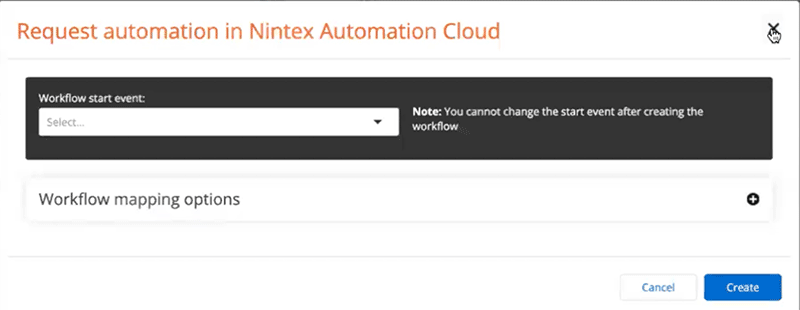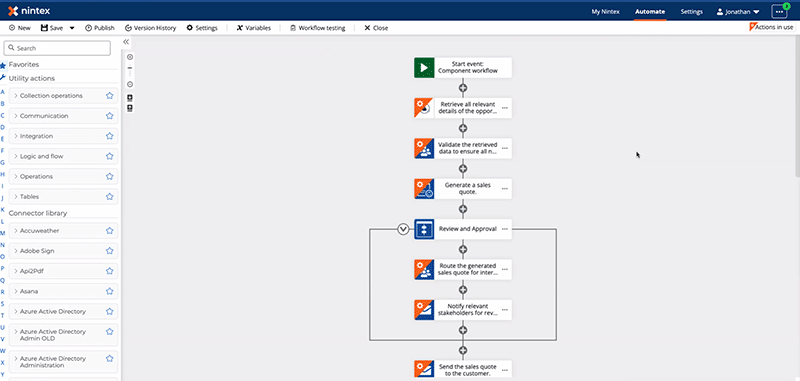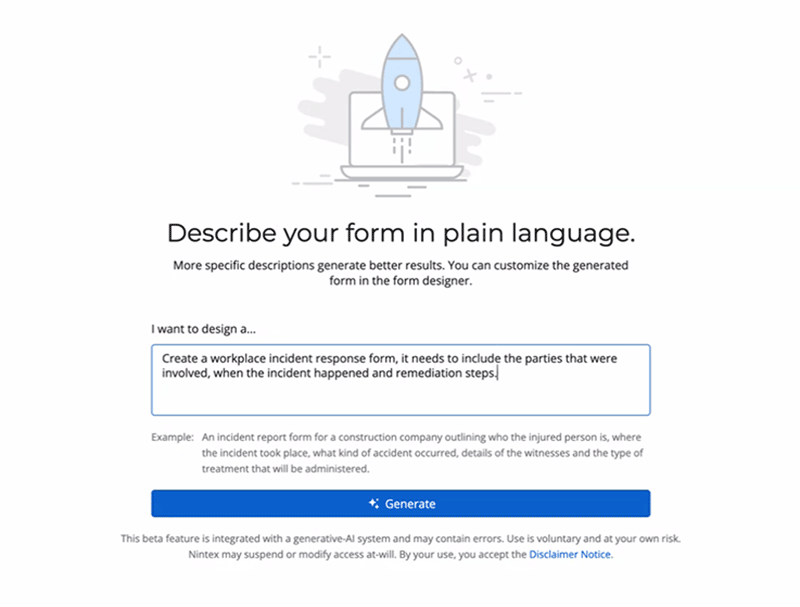Process automation has become an essential element in any organization’s pursuit of process excellence. It’s part of the ongoing improvement cycle that engages your teams, increases time to value, and boosts product or service quality for customers.
It’s not a silver bullet, though—automation relies on many factors to be truly effective in a business context, including your priorities, people, and tools.
Let’s dive into the elements of process excellence and how one specific tool, Nintex Workflow Generator, helps you achieve it.
Six elements of process excellence
Process excellence sounds like a “gold star” achievement, the state all businesses aspire to attain. But it’s really more like a journey of continuously improving processes—mapping, analyzing, and tweaking them—to work toward the most optimal state.
By definition, getting on the path to process excellence can be transformative. It’s about changing how work gets done in your company. By removing bottlenecks, redundancies, and inefficiencies, you achieve better outcomes for less cost. And that means higher efficiency, effectiveness, and quality while reducing waste and improving your bottom line.
To achieve the best results, you need to strive to create a process excellence approach that is:
1. Foundational
The companies that get the most powerful results are the ones that build a process culture. This starts at the top, with the responsibility falling on leadership’s shoulders to educate workers about process excellence and why it’s so important.
That means leaders need to carve out time to share their desired outcomes and how they align with organizational goals. They need to meet with process owners and end users to see documentation and ask questions like “How are we doing this?” and “Why are we doing it that way?” Seeing leaders’ interest and enthusiasm can have a trickle-down effect, helping to secure buy-in across the org.
2. Intentional
Achieving process excellence means prioritizing the right processes. Start with the ones that are clearly aligned with business goals and have the highest potential return on investment.
“You get into a virtuous flywheel,” says Jonathan Butler, Group Product Manager at Nintex. “You identify the biggest opportunity for improvement first. Then, you execute on that, which opens up revenue to build more things—and then optimize, which opens up even more revenue.”
3. Visible
Process excellence requires visibility and discovery. You need to identify, document, and map processes, including what you do and how you do it—and store them in a central, accessible location. This helps you achieve data democratization and improves collaboration across line of business owners and technical owners.
To achieve visibility, open lines of communication about what process management tools you should use, where processes should live, and how to ensure that all team members have access. “When you start implementing automation tools, do you still want all of that to live in email? Or should it happen where the work happens?” Butler asks.
4. Detailed
Process excellence involves getting granular about what you do and how you do it. This starts in the data collection process with thorough interviews with or observations of process users and managers. You need to understand each activity or task, any inputs or outputs required, task dependencies, and decision points along the way.
You must also determine how to present that information in a way that balances granularity and digestibility. For example, you might decide to use a complex process model to present a very technical task, or you might opt for a process map, which is a bit simpler, so users can pick it up and instantly orient themselves.
“If you can’t prioritize, standardize, and document the way that you run your business, how will you optimize areas to continue to generate revenue or increase revenue generation?”
–Jonathan Butler, Group Product Manager at Nintex
5. User friendly
It’s pointless to document your processes if no one follows them. Consider ease of use to achieve process improvement and excellence. This includes choosing a process management tool with a clear user interface (UI), artificial intelligence (AI) assistance, drag-and-drop functionality, and minimal coding requirements.
You also want the workflows you generate to be easy to understand for the typical user—minimizing or hiding extra details or visual clutter. Ultimately, you want your tool and its outputs to encourage better adoption and more productive end users.
6. Flexible
Process excellence is all about striving for continuous improvement, and continuous improvement means constant change. To achieve that, you need both a growth mindset and a flexible tool to easily modify your processes as you scale. This allows you to accommodate increased volume or complexity without sacrificing quality or performance.
A flexible tool also lets you make changes to your processes and workflows more quickly, improving your time to value for the sake of both customer satisfaction and your bottom line.
Achieve process excellence with the Nintex Workflow Generator
The Nintex Workflow Generator, part of the Nintex Automation Cloud, lets you easily create workflows using simple text descriptions. Powered by generative AI, the Nintex Workflow Generator uses best practices from thousands of workflows to build and streamline complex processes.
Instead of letting the technical barriers of automation slow down process improvement, Nintex facilitates easy and effective collaboration between the process experts and technical specialists with powerful tools that create automation solutions with a few clicks instead of lines of code.
Let’s take a closer look at some of its capabilities:
Request process automation
With Workflow Generator, you can request process automation directly from the process map in Nintex Process Manager. That means process experts can click a button to nominate processes to optimize for automation.

A new capability also lets you request automation from within the process itself, submitting it for review. Just type in what your goals for the automation are, the process frequency, and how long it will likely take.
The system will tell you whether the process is a good candidate for automation based on the inputs. Then, in the Nintex Improvements module, your IT team will get a list of these new requests and be able to review and refine the process before finalizing the workflow creation.
For example, you might ask the system to review your employee onboarding workflow and calculate its automation potential. If it finds optimization possibilities, you can submit this to IT for review, refinement, and publishing.
Build a workflow
Using natural language processing (NLP), the process owner can say whether they want to generate all of the process or only certain steps. The tool then identifies the optimal activities to include in the workflow and shows them a preview, which the process owner can adjust.
Once confirmed, the platform automatically transfers these choices into a Nintex workflow framework and informs the workflow designer. The designer gets a copy of the source process alongside the templated automation, encouraging stronger and clearer collaboration between teams and ensuring each can focus on their specialized strength with all the information they need at hand.
When the workflow designer finishes their work, it appears in the Process Manager environment. The process expert who requested the change gets a notification to review the mapping of each activity before publishing the newly automated process for the organization.
For example, you could generate a workflow to create a sales quote, route it for approval, and send it to the customer—automating any or all relevant steps in the process.

Create forms
Enter your requirements for a form needed in your workflow, describing it in natural language. Then, simply click a button to generate the form.
For example, you could ask the tool to create a workplace incident response form. Instead of scouring the web for examples and then dragging and dropping questions onto a canvas, just briefly describe what you want the form to accomplish. The tool will create the form for you, and then you can tweak it or customize it from there.

Track automations
Users can also track automations through the Automation tab. All workflows are listed there, with links to the associated processes. Automated documents like input forms are included in the document library, with custom icons so they’re easy to identify.
Within the processes themselves, automated elements show up with highlighted activity boxes and dedicated swimlanes to make it clear where the workflows begin and end, giving greater visibility to handoff points and the efficiencies gained through automation.
How Workflow Generator helps you achieve process excellence
Workflow Generator helps you achieve process excellence by reducing the time it takes to generate a cohesive workflow with manual actions and automations. Instead of change feeling like a chore, you know that you can use NLP commands and a drag-and-drop to make optimizing easier.
This makes life easier for just about everyone:
- For the line of business leader, Workflow Generator makes it much easier to collaborate with your automation specialists and provides the tools they need to do their jobs.
- For the automation specialists, it simplifies starting with the workflow design and getting to a finalized implementation even faster.
- For the end user, it means improved processes and better automation, so they have more time for strategic tasks.
The benefits for individual users add up fast. As a result, the organization as a whole sees steps toward process excellence and a process culture that leads to improved customer outcomes and better business and revenue growth.
The path to collaboration and continuous improvement
It’s not hyperbole: process excellence holds transformative potential for your organization. It offers improved efficiency and quality while managing costs and complexity.
But it’s not always easy to get there—you need a combination of strong leadership, buy-in, and a culture of continuous improvement to make it happen.
With the right tools—like Nintex Workflow Generators—it’s much easier.
Nintex Workflow Generator increases collaboration between technical specialists and the people who know the processes best. By creating the workflows directly from the procedure, you get greater clarity around the requirements, and solutions can be developed faster, with less need for reworking.
The result is easy custom automation you can embed directly in your workflows.
Request a demo today to see how Nintex Workflow Generator can help you achieve process excellence in your organization.







